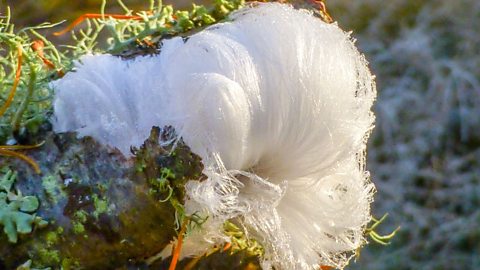The thing with science is that it’s all about facts.
For example, we know that rain falls from clouds due to the water cycle. Scientific investigation proved that the Sun’s heat evaporates water from the Earth’s surface, which rises and condenses into clouds. When the clouds become too heavy, the water returns to the surface as rain, or even snow. It collects into seas, lakes and rivers and the cycle begins again. It’s a fact.
But what about the things science has no explanation for, even if they've become part of our lives and we may not even think to question them? We've taken a look at just some of the phenomena that have had experts scratching their heads for years.
Nothing as purr
Cat owners will testify the sheer pleasure of having your favourite moggy pal curled up on your lap and purring away contentedly.
But although we may see it as the equivalent of a contented grin or a dog’s wagging tail, there is an air of mystery behind these feline sounds.

The actual source of a purr was an enigma for a long time. It was only fairly recently that experts suggested an alternate constriction and relaxation of the muscles around a cat’s larynx is what makes the noise itself, when the cat breathes in and out. But it’s the why, rather than the what, which still has people scratching their heads.
One of the more surprising explanations is that cats don’t just purr when they are happy and relaxed, they also purr when they are in pain. Kittens and their mother also purr to provide reassurance and bonding. However, a US-based veterinarian has suggested that the frequency of a purr is beneficial to helping bones grow and develop too. They are of similar frequency to those used in modern therapy to heal damaged bones and other tissues, so help to self-soothe and heal when a cat is ill or injured. It’s very much a theory, meaning the reason our cats keep on purring remains a little bit baffling.
The glass act
Pick up a glass. Perhaps even pour something in it. It all feels pretty solid in your grip.

However, what you are holding is one of the most unusual solids of them all. Glass is what is known as an amorphous - or non-crystalline - solid. Unlike other solid objects, it does not have a well-ordered molecular structure. However, that structure is not irregular enough for it to qualify as a liquid. If you have ever heard anyone describe glass as a liquid that is moving incredibly slowly, it’s not actually true.
When glass goes from its molten form, where it can be shaped into all sorts of things, to its cooler, solid state, the molecules that move freely within a liquid slow down, but don’t slot into a regular pattern. Their arrangement is chaotic by comparison and has been compared to a still image of liquid molecules.
And why does this happen? Well, nobody really knows…
A good old yawn
We try to stifle them in polite company and use them as a signal to head for the pillow, but yawning is a mystery to scientists. They’re still not entirely sure why we do it.

One explanation is that the act of yawning helps keep our temperature at a steady level, and cools our brain down. But that remains a theory.
Another mystery is why our yawns seem to be catching. How often have you found yourself yawning, even if you’re not tired, purely because someone else nearby is doing it?
A 2005 study suggested this was down to our brain’s ability to empathise with those around us. Interestingly, it seems chimpanzees will also copy humans when they let out a yawn as well - but why that's happening in the first place still hasn't been pinned down in fact.
How a tomato came to have more genes than a human
Place a human being next to a tomato and they couldn’t look more different. But they do have one thing in common: genes. It’s what all organisms possess and, known as our DNA, our genes basically determine who we are and what we look like.

A tomato may not look as complex as a person. However, it takes around 7,000 more genes to make one (about 30,000 in total) than it does a human being. Basically, there is more genetic information in your bottle of ketchup than it took to create Greta Thunberg, Nelson Mandela, Dua Lipa… or you.
In recent years, some explanation has been found for this quirk in DNA.
It dates back to around 70 million years ago, when the family the tomato belongs to tripled its number of genes (also known as its genome), meaning each gene had three copies. As time progressed, the extra genes which served no purpose disappeared, but those that were useful remained, leading to the high number of genes in a tomato today. Humans, on the other hand, seem to be more efficient with the fewer genes they have. A technique called alternative splicing means one gene can be assembled in different ways (like adding or removing building blocks), so it can produce different things.
How the tomato managed to triple its gene count is still a mystery. It did happen at around the same time that the dinosaurs perished, so one theory is that packing all that extra DNA helped ensure its survival during a rocky time on planet Earth.
Slippery when frozen
We take care when walking on ice. Why? Well, its surface has far less friction than, say, a carpet or wooden floorboards, which is why our feet can disappear from beneath us and send us skidding if we step out on a frozen pavement on a winter’s day.
You’ve probably got the hang of this part by now - but scientists still can’t come up with a conclusive answer how this happens.

It’s widely accepted that the reason ice is so slippery is due to a thin film of liquid on its surface. The mystery is why this layer forms at all. For many years, it was thought this was due to external pressure (such as an ice skater moving across it) melting the top of the icy surface.
However, further research suggests that an ice skater would not be able to apply the appropriate amount of pressure to do this, even if their weight was concentrated on one skate. Recent studies suggest that surface ice does not fully transform into liquid water, but instead ends up in a mixed state between ice and water. The mystery of sliding on ice could thus be attributed to the viscous (or slimy) nature of this film. It could be - but it’s by no means a fact.
In collaboration with: Professor Georgina Jackson and Professor Stephen Jackson, University of Nottingham; Maggie Roberts, director of veterinary services, Cats Protection; Professor Dr Carsten Welsch, University of Liverpool; Professor Julie Ahringer, University of Cambridge.
Science fiction or science fact?
It's a Bitesize quiz, Captain, but not as we know it...

Ten cats that made history
You spend all day scrolling through videos of them on the internet, now learn about the ones that made history.

Hair ice? Ice pancakes? Diamond dust? Here's the science behind these magical ice phenomena.
